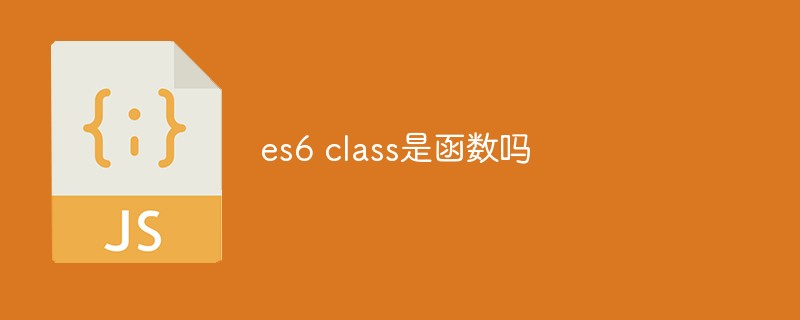es6 class是函数。在es6中,class(类)作为对象的模板被引入,可以通过class关键字定义类,语法为“class 类名{...};class的本质就是function(函数),它是一个语法糖,其底层是通过“构造函数”去创建的。

本教程操作环境:windows7系统、ECMAScript 6版、Dell G3电脑。
es6 class是函数。
在ES6中,class (类)作为对象的模板被引入,可以通过 class 关键字定义类。
class 的本质是 function。
它可以看作一个语法糖,其底层还是通过 构造函数 去创建的,让对象原型的写法更加清晰、更像面向对象编程的语法。
function Person(name, age) {
this.name = name;
this.age = age;
}
Person.prototype.sayName = function() {
return this.name;
}
const xiaoming = new Person('小明', 18);
console.log(xiaoming);上面代码用ES6的class实现,就是下面这样
class Person {
constructor(name, age) {
this.name = name;
this.age = age;
}
sayName() {
return this.name;
}
}
const xiaoming = new Person('小明', 18)
console.log(xiaoming);
// { name: '小明', age: 18 }
console.log((typeof Person));
// function
console.log(Person === Person.prototype.constructor);
// trueconstructor方法,这就是构造方法,this关键字代表实例对象。 类的数据类型就是函数,类本身就指向构造函数。
定义类的时候,前面不需要加 function, 而且方法之间不需要逗号分隔,加了会报错。
类的所有方法都定义在类的prototype属性上面。
class A {
constructor() {}
toString() {}
toValue() {}
}
// 等同于
function A () {
// constructor
};
A.prototype.toString = function() {};
A.prototype.toValue = function() {};在类的实例上面调用方法,其实就是调用原型上的方法。
let a = new A(); a.constructor === A.prototype.constructor // true
类的实例
实例的属性除非显式定义在其本身(即定义在this对象上),否则都是定义在原型上(即定义在class上)。
注意:
1、class不存在变量提升
new A(); // ReferenceError
class A {}因为 ES6 不会把类的声明提升到代码头部。这种规定的原因与继承有关,必须保证子类在父类之后定义。
{
let A = class {};
class B extends A {}
}上面的代码不会报错,因为 B继承 A的时候,A已经有了定义。但是,如果存在 class提升,上面代码就会报错,因为 class 会被提升到代码头部,而let命令是不提升的,所以导致 B 继承 A 的时候,Foo还没有定义。
2、this的指向 类的方法内部如果含有this,它默认指向类的实例。但是,必须非常小心,一旦单独使用该方法,很可能报错。
继承
Class 可以通过extends关键字实现继承
class Animal {}
class Cat extends Animal { };上面代码中 定义了一个 Cat 类,该类通过 extends关键字,继承了 Animal 类中所有的属性和方法。 但是由于没有部署任何代码,所以这两个类完全一样,等于复制了一个Animal类。 下面,我们在Cat内部加上代码。
class Cat extends Animal {
constructor(name, age, color) {
// 调用父类的constructor(name, age)
super(name, age);
this.color = color;
}
toString() {
return this.color + ' ' + super.toString(); // 调用父类的toString()
}
}constructor方法和toString方法之中,都出现了super关键字,它在这里表示父类的构造函数,用来新建父类的this对象。
子类必须在 constructor 方法中调用 super 方法,否则新建实例就会报错。 这是因为子类自己的this对象,必须先通过 父类的构造函数完成塑造,得到与父类同样的实例属性和方法,然后再对其进行加工,加上子类自己的实例属性和方法。如果不调用super方法,子类就得不到this对象。
class Animal { /* ... */ }
class Cat extends Animal {
constructor() {
}
}
let cp = new Cat();
// ReferenceErrorCat 继承了父类 Animal,但是它的构造函数没有调用super方法,导致新建实例报错。
如果子类没有定义constructor方法,这个方法会被默认添加,代码如下。也就是说,不管有没有显式定义,任何一个子类都有constructor方法。
class Cat extends Animal {
}
// 等同于
class Cat extends Animal {
constructor(...args) {
super(...args);
}
}另一个需要注意的地方是,es5 的构造函数在调用父构造函数前可以访问 this, 但 es6 的构造函数在调用父构造函数(即 super)前不能访问 this。
class A {
constructor(x, y) {
this.x = x;
this.y = y;
}
}
class B extends A {
constructor(x, y, name) {
this.name = name; // ReferenceError
super(x, y);
this.name = name; // 正确
}
}上面代码中,子类的constructor方法没有调用super之前,就使用this关键字,结果报错,而放在super方法之后就是正确的。
父类的静态方法,也会被子类继承。
class A {
static hello() {
console.log('hello world');
}
}
class B extends A {
}
B.hello() // hello world【相关推荐:javascript视频教程、web前端】
以上是es6 class是函数吗的详细内容。更多信息请关注PHP中文网其他相关文章!
 html内部的反应:集成了动态网页的JavaScriptApr 16, 2025 am 12:06 AM
html内部的反应:集成了动态网页的JavaScriptApr 16, 2025 am 12:06 AM要将React集成到HTML中,需遵循以下步骤:1.在HTML文件中引入React和ReactDOM。2.定义一个React组件。3.使用ReactDOM将组件渲染到HTML元素中。通过这些步骤,可以将静态HTML页面转化为动态、交互式的体验。
 反应的好处:性能,可重用性等等Apr 15, 2025 am 12:05 AM
反应的好处:性能,可重用性等等Apr 15, 2025 am 12:05 AMReact受欢迎的原因包括其性能优化、组件复用和丰富的生态系统。1.性能优化通过虚拟DOM和diffing机制实现高效更新。2.组件复用通过可复用组件减少重复代码。3.丰富的生态系统和单向数据流增强了开发体验。
 反应:创建动态和交互式用户界面Apr 14, 2025 am 12:08 AM
反应:创建动态和交互式用户界面Apr 14, 2025 am 12:08 AMReact是构建动态和交互式用户界面的首选工具。1)组件化与JSX使UI拆分和复用变得简单。2)状态管理通过useState钩子实现,触发UI更新。3)事件处理机制响应用户交互,提升用户体验。
 React与后端框架:比较Apr 13, 2025 am 12:06 AM
React与后端框架:比较Apr 13, 2025 am 12:06 AMReact是前端框架,用于构建用户界面;后端框架用于构建服务器端应用程序。React提供组件化和高效的UI更新,后端框架提供完整的后端服务解决方案。选择技术栈时需考虑项目需求、团队技能和可扩展性。
 HTML和React:标记与组件之间的关系Apr 12, 2025 am 12:03 AM
HTML和React:标记与组件之间的关系Apr 12, 2025 am 12:03 AMHTML和React的关系是前端开发的核心,它们共同构建现代Web应用的用户界面。1)HTML定义内容结构和语义,React通过组件化构建动态界面。2)React组件使用JSX语法嵌入HTML,实现智能渲染。3)组件生命周期管理HTML渲染,根据状态和属性动态更新。4)使用组件优化HTML结构,提高可维护性。5)性能优化包括避免不必要渲染,使用key属性,保持组件单一职责。
 反应与前端:建立互动体验Apr 11, 2025 am 12:02 AM
反应与前端:建立互动体验Apr 11, 2025 am 12:02 AMReact是构建交互式前端体验的首选工具。1)React通过组件化和虚拟DOM简化UI开发。2)组件分为函数组件和类组件,函数组件更简洁,类组件提供更多生命周期方法。3)React的工作原理依赖虚拟DOM和调和算法,提高性能。4)状态管理使用useState或this.state,生命周期方法如componentDidMount用于特定逻辑。5)基本用法包括创建组件和管理状态,高级用法涉及自定义钩子和性能优化。6)常见错误包括状态更新不当和性能问题,调试技巧包括使用ReactDevTools和优
 React和前端堆栈:工具和技术Apr 10, 2025 am 09:34 AM
React和前端堆栈:工具和技术Apr 10, 2025 am 09:34 AMReact是一个用于构建用户界面的JavaScript库,其核心是组件化和状态管理。1)通过组件化和状态管理简化UI开发。2)工作原理包括调和和渲染,优化可通过React.memo和useMemo实现。3)基本用法是创建并渲染组件,高级用法包括使用Hooks和ContextAPI。4)常见错误如状态更新不当,可使用ReactDevTools调试。5)性能优化包括使用React.memo、虚拟化列表和CodeSplitting,保持代码可读性和可维护性是最佳实践。
 React在HTML中的作用:增强用户体验Apr 09, 2025 am 12:11 AM
React在HTML中的作用:增强用户体验Apr 09, 2025 am 12:11 AMReact通过JSX与HTML结合,提升用户体验。1)JSX嵌入HTML,使开发更直观。2)虚拟DOM机制优化性能,减少DOM操作。3)组件化管理UI,提高可维护性。4)状态管理和事件处理增强交互性。


热AI工具

Undresser.AI Undress
人工智能驱动的应用程序,用于创建逼真的裸体照片

AI Clothes Remover
用于从照片中去除衣服的在线人工智能工具。

Undress AI Tool
免费脱衣服图片

Clothoff.io
AI脱衣机

AI Hentai Generator
免费生成ai无尽的。

热门文章

热工具

Dreamweaver Mac版
视觉化网页开发工具

EditPlus 中文破解版
体积小,语法高亮,不支持代码提示功能

Atom编辑器mac版下载
最流行的的开源编辑器

VSCode Windows 64位 下载
微软推出的免费、功能强大的一款IDE编辑器

SublimeText3 Mac版
神级代码编辑软件(SublimeText3)





